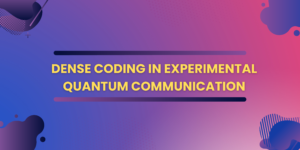Dense Coding in Experimental Quantum Communication, Quantum communication, plays a vital role in Quantum technologies and explores the secure and efficient transmission of information using the principles of quantum mechanics. An important concept of dense coding plays a pivotal role, offering a unique approach to maximize information transfer.

The Foundations of Dense Coding in Quantum Communication
Dense coding in quantum communication exploits the principles of quantum entanglement to achieve more efficient information transmission. Entanglement allows two quantum particles, typically qubits, to become correlated in such a way that the state of one immediately influences the state of the other, regardless of the physical distance between them.
Dence Coding Explained
‘Dense coding is a quantum communication protocol that allows a sender to communicate multiple classical bits of information by transmitting a smaller number of qubits. It refers to a specific approach in quantum coding that optimizes the representation of information. It involves efficiently encoding quantum states to enhance computational processes. The term ‘dense’ reflects the concentrated and optimized nature of the coding approach.’
For a better understanding of the Dense coding click here
Experimental Setups for Dense Coding
Experimental implementations of dense coding involve sophisticated setups to create and maintain entangled qubits and perform precise measurements. Several key components characterize these experimental setups:
Source of Entangled Qubits: Typically, experimental setups use sources such as parametric down-conversion crystals or superconducting circuits to generate entangled qubits.
Quantum Gates and Manipulation: Quantum gates play a crucial role in manipulating the qubits during the encoding process. Precise control over quantum gates ensures the accurate encoding of classical information.
Measurement Devices: Specialized detectors and measurement devices are employed to extract classical information from the received qubits. These devices must be sensitive enough to capture the subtle quantum states involved.
Applications of Dense Coding in Experimental Quantum Communication
- Quantum Key Distribution (QKD): Dense coding enhances the security of QKD protocols by enabling the transmission of more key information using fewer qubits. This contributes to the development of robust and efficient quantum cryptographic systems.
- Quantum Teleportation: Experimental implementations of dense coding have been instrumental in advancing quantum teleportation, where the state of a quantum system is transmitted from one location to another. This has implications for the future development of quantum networks.
- Quantum Repeaters: Dense coding plays a crucial role in the development of quantum repeaters, a key technology for extending the range of quantum communication. By efficiently encoding information, dense coding contributes to the creation of more reliable and longer-distance quantum communication links.
Challenges and Advances in Experimental Dense Coding
- Quantum Error Correction: One of the primary challenges in experimental dense coding is addressing errors that can arise due to the delicate nature of quantum states. Advances in quantum error correction techniques are pivotal for enhancing the reliability of experimental setups.
- Resource Scalability: Scaling up experimental setups to handle larger numbers of entangled qubits is a challenge. Researchers are exploring innovative methods to ensure the scalability of dense coding experiments without compromising efficiency.
Future Prospects and Collaborative Research
As experimental quantum communication continues to evolve, the future of dense coding holds exciting prospects:
- Integration with Quantum Networks: Dense coding is anticipated to play a crucial role in the integration of quantum communication into broader quantum networks, enabling secure and efficient information transfer on a large scale.
- The collaborative efforts of researchers, physicists, and engineers are crucial for pushing the boundaries of experimental dense coding. Multidisciplinary collaborations contribute to innovative solutions and breakthroughs in quantum communication technologies.
Conclusion
In conclusion, we can say that Dense coding in experimental quantum communication represents a groundbreaking approach to maximize the efficiency of information transmission using the principles of quantum entanglement.
Frequently Asked Questions (FAQs)
How does dense coding work in experimental quantum communication?
Ans-In experimental quantum communication, dense coding leverages quantum entanglement to efficiently encode and transmit classical information using fewer qubits, contributing to secure and efficient information transfer.
What are the key components of experimental setups for dense coding in quantum communication?
Ans- Key components include a source of entangled qubits, quantum gates for manipulation, and specialized measurement devices to extract classical information from received qubits.
What are the applications of dense coding in experimental quantum communication?
Ans- Dense coding applications include enhancing the security of Quantum Key Distribution (QKD), advancing quantum teleportation, and contributing to the development of quantum repeaters for longer-distance communication.
To learn from the internet click here
Also, refer to our articles
Dense Coding(DC) in Quantum Computation- plays a crucial role [click here]
Dense Coding Network(DCN): Enhancing Quantum Efficiency [click here]
